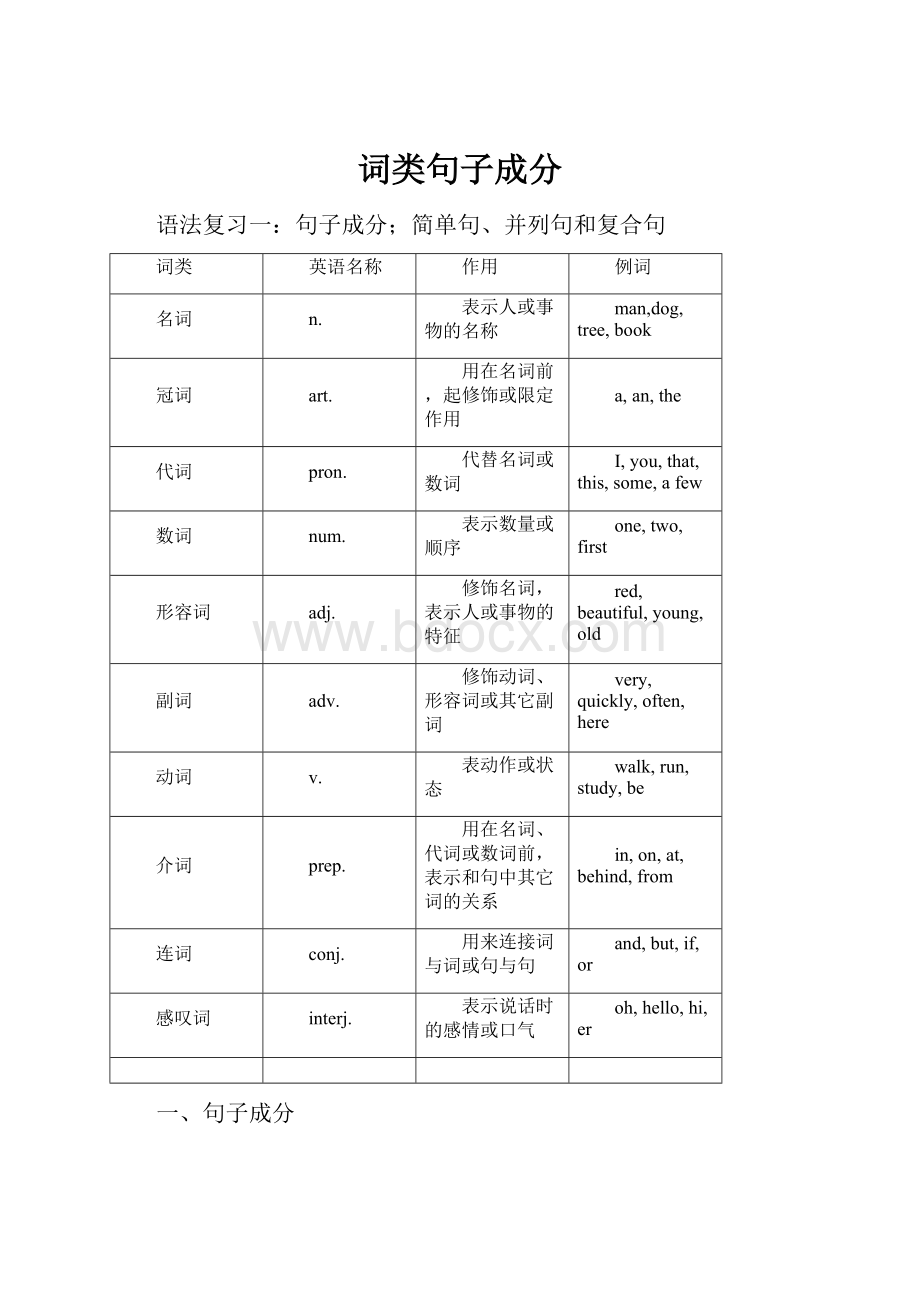词类句子成分.docx
《词类句子成分.docx》由会员分享,可在线阅读,更多相关《词类句子成分.docx(35页珍藏版)》请在冰豆网上搜索。

词类句子成分
语法复习一:
句子成分;简单句、并列句和复合句
词类
英语名称
作用
例词
名词
n.
表示人或事物的名称
man,dog,tree,book
冠词
art.
用在名词前,起修饰或限定作用
a,an,the
代词
pron.
代替名词或数词
I,you,that,this,some,afew
数词
num.
表示数量或顺序
one,two,first
形容词
adj.
修饰名词,表示人或事物的特征
red,beautiful,young,old
副词
adv.
修饰动词、形容词或其它副词
very,quickly,often,here
动词
v.
表动作或状态
walk,run,study,be
介词
prep.
用在名词、代词或数词前,表示和句中其它词的关系
in,on,at,behind,from
连词
conj.
用来连接词与词或句与句
and,but,if,or
感叹词
interj.
表示说话时的感情或口气
oh,hello,hi,er
一、句子成分
(一)句子成分的定义:
构成句子的各个部分叫做句子成分。
句子成分有主要成分和次要成分;主要成分有主语和谓语;次要成分有表语、宾语、定语、状语、补足语和同位语。
(二)主语:
主语是一个句子所叙述的主体,一般位于句首。
但在therebe结构、疑问句(当主语不疑问词时)和倒装句中,主语位于谓语、助动词或情态动词后面。
主语可由名词、代词、数词、不定式、动名词、名词化的形容词和主语从句等表示。
例如:
Duringthe1990s,Americancountrymusichasbecomemo
reandmorepopular.(名词)
WeoftenspeakEnglishinclass.(代词)
One-thirdofthestudentsinthisclassaregirls.(数词)
Toswimintheriverisagreatpleasure.(不定式)
Sm
okingdoesharmtothehealth.(动名词)
Theri
chshouldhelpthepoor.(名词化的形容词)
WhenwearegoingtohaveanEnglishtesthasnotbeendecided.(主语从句)
Itisnecessarytomasteraforeignlanguage.(it作形式主语,真正的主语为后面的不定式)
(三)谓语:
谓语说明主语所做的动作或具有的特征和状态。
动词在句中作谓语,一般放在主语之后。
谓语的构成如下:
1、简单谓语:
由一个动词或动词短语构成。
如:
Hepracticesrunningeverymorning.
2、复合谓语:
(1)由情态动词或其他助动词加动词原形构成。
如:
Youmaykeepthebookfortwoweeks.Hehascaughtabadcold.
(2)由系动词加表语构成。
如:
Wearestudents.
(四)表语:
表语用以说明主语的身份、特征和状态,它一般位于系动词(如be,become,get,look,grow,turn,seem等)之后。
表语一般由名词、代词、形容词、分词、数词、不定式、动名词、介词短语、副词及表语从句表示。
例如:
OurteacherofEnglishisanAmerican.(名词)
Isityours?
(代词)
Theweatherhasturnedcold.(形容词)
Thespeechisexciting.(分词)
Threetimessevenistwentyone?
(数词)
HisjobistoteachEnglish.(不定式)
Hishobby(爱好)isplayingfootball.(动名词)
Themachinemustbeoutoforder.(介词短语)
Timeisup.Theclassisover.(副词)
Thetruthisthathehasneverbeenabroad.(表语从句)
(五)宾语:
宾语表示动作的对象或承爱者,一般位于及物动词和介词后面。
例如:
Theywenttoseeanexhibition(展览)yesterday.(名词)
Theheavyrainpreventedmeformcomingtoschoolontime.(代词)
Howmanydictionariesdoyouhave?
Ihavefive.(数词)
Theyhelpedtheoldwiththeirhouseworkyesterday.(名词化形容词)
Hepretendednottoseeme.(不定式短语)
Ienjoylisteningtopopularmusic.(动名词短语)
Ithink(that)heisfitforhisoffice.(宾语从句)
宾语种类:
(1)双宾语(间接宾语+直接宾语),例如:
Lendmeyourdictionary,please.
(2)复合宾语(宾语+宾补),例如:
Theyelectedhimtheirmonitor.
(六)宾语补足语:
英语中有些及物动词,除有一个直接宾语以外,还要有一个宾语补语,才能使句子的意义完整。
带有宾语补足语的一般句型为:
某些及物动词(如make等+宾语+宾补)。
宾补可由名词、形容词、副词、不定式、分词、介词短语和从句充当。
例如:
HisfathernamedhimDongming.(名词)
Theypaintedtheirboatwhite.(形容词)
Letthefreshairin.(副词)
Youmustn’tforcehimtolendhismoneytoyou.(不定式短语)
Wesawherenteringtheroom.(现在分词)
Wefoundeverythinginthelabingoodorder.(介词短语)
Wewillsoonmakeourcitywhatyourcityisnow.(从句)
(七)定语:
修饰名词或代词的词、短语或从句称为定语。
定语可由以下等成分表示:
Guilinisabeautifulcity.(形容词)
Chinaisadevelopingcountry;Americaisadevelopedcountry.(分词)
Therearethirtywomenteachersisourschool.(名词)
HisrapidprogressinEnglishmadeussurprised.(代词)
Ourmonitorisalwaysthefirsttoentertheclassroom.(不定式短语)
Theteachingplanfornexttermhasbeenworkedout.(动名词)
HeisreadinganarticleabouthowtolearnEnglish.(介词短语)
(八)状语:
修饰动词、形容词、副词或整个句子,说明动作或状态特征的句子成分,叫做状语。
可由以下形式表示:
Lighttravelsmostquickly.(副词及副词性词组)
Hehaslivedinthecityfortenyears.(介词短语)
Heisproudtohavepassedthenationalcollegeentranceexamination.(不定式短语)
Heisintheroommakingamodelplane.(分词短语)
Waitaminute.(名词)
Onceyoubegin,youmustcontinue.(状语从句)
状语种类如下:
Howaboutmeetingagainatsix?
(时间状语)
Lastnightshedidn’tgotothedancepartybecauseoftherain.(原因状语)
Ishallgothereifitdoesn’train.(条件状语)
MrSmithlivesonthethirdfloor.(地点状语)
Sheputtheeggsintothebasketwithgreatcare.(方式状语)
Shecameinwithadictionaryinherhand.(伴随状语)
Inordertocatchupwiththeothers,Imustworkharder.(目的状语)
Hewassotiredthathefellasleepimmediately.(结果状语)
Sheworksveryhardthoughsheisold.(让步状语)
Iamtallerthanheis.(比较状语)
练习一
一、指出下列句子划线部分是什么句子成分:
1.Thestudentsgotontheschoolbus.
2.Hehandedmethenewspaper.
3.Ishallansweryourquestionafterclass.
4.WhatabeautifulChinesepainting!
5.Theywenthuntingtogetherearlyinthemorning.
6.Hisjobistotrainswimmers.
7.HetookmanyphotosofthepalacesinBeijing.
8.ThereisgoingtobeanAmericanfilmtonight.
9.HeistoleaveforShanghaitomorrow.
10.Hiswishistobecomeascientist.
11.Hemanagedtofinishtheworkintime.
12.Tomcametoaskmeforadvice.
13.HefounditimportanttomasterEnglish.
14.Doyouhaveanythingelsetosay?
15.Tobehonest;yourpronunciationisnotsogood.
16.Wouldyoupleasetellmeyouraddress?
17.Hesatthere,readinganewspaper.
18.Itisourdutytokeepourclassroomcleanandtidy.
19.Henoticedamanentertheroom.
20.Theapplestastedsweet.
二、用符号划出下列短文各句中的主语(—)、谓语(=)、宾语(~):
Ihopeyouareverywell.I'mfine,buttired.RightnowitisthesummervacationandI'mhelpingmyDadonthefarm.Augustisthehottestmonthhere.Itisthetimeofyearforthericeharvest,soeverydayIworkfromdawnuntildark.Sometimeswegoonworkingafterdarkbythelightsofourtractors.WegrowriceinthesouthoftheStates,butinthenorthwhereitiscoldertheygrowwheat.Wehavealotofmachinesonthefarm.Althoughthefarmislarge,myDadhasonlytwomenworkingforhim.Butheemploysmoremenfortheharvest.Mybrothertakescareofthevegetablegarden.Itdoesn'toftenraininthesummerhere.Asaresult,wehavetowaterthevegetablegarden.Everyeveningwepumpwaterfromawell.Itthenrunsalongchannelstodifferentpartsofthegarden.
三、用符号划出下列短文各句中的定语(—)、状语(=)、补语(~):
MostSaturdayeveningsthereisaparty,evenatharvesttime.Thesepartiesoftenmakeusveryhappy.Wecookmeatonanopenfireoutside.It'sgreat!
Americanseatalotofmeat—toomuchinmyopinion.Someofmyfriendsdrinkbeer.Idon't,becauseIhavetodrivehomeaftertheparty.InyourletteryouaskedaboutthetimeindifferentareasoftheStates.TherearefivedifferenttimeareasintheStates.InmystatewearefourteenhoursbehindBeijingtime.HowmanydifferenttimeareasdoyouhaveinChina?
Well,Imuststopandgetsomesleep.Pleasegivemybestregardstoyourparents.
四、选择填空:
()1.____willleaveforBeijing.
A.NowtherethemanB.Themanherenow
C.Themanwhoisherenow
D.Themanisherenow
()2.Theweather____.
A.wetandcoldB.is
wetandcoldC.notwetandcoldD.werewetandcold
()3.Theappletasted____.
A.sweetsB.sweetlyC.nicelyD.sweet
()4.Hegotup____yesterdaymorning.
A.latelyB.lateC.latestD.latter
()5.Theactor______attheageof70.
A.deadB.diedC.dyedD.deaded
()6.____wereallverytired,butnoneof____wouldstoptotakearest.
A.We,usB.Us,weC.We,ou
rD.We,we
()7.Hefoundthestreetmuch______.
A.crowdB.crowdingC.crowdedD.crowdedly
()8.Ithink_____necessarytolearnEnglishwell.
A.itsB.itC.thatD.thatis
()9.Thedog____mad.
A.looksB.islookedC
.isbeinglookedD.waslooked
()10.Iwillneverforgettheday______Ijoinedthearmy.
A.thatB.whenC.inwhichD.where
参考答案:
练习一:
一、1、主语,定语;2、间接宾语;3、谓语,状语;4、定语;5、状语,状语;6、定语,表语;7、宾语,状语;8、谓语,主语;9、谓语;10、主语,表语;11、谓语,宾语;12、状语;13、形式宾语,真正宾语;14、宾语、定语;15、插入语,状语;16、宾语(间宾+直宾);17、状语,状语;18、形式主语,表语,宾补;19、宾补;20、表语
二、略
三、略
四、1~5CBDBB6~10ACBAB
九.动词的时态和语态
动词时态(tense)是一种动词形式,不同的时态用以表示不同时间里所产生的动作或存在的状态。
从种类上看英语有16种时态,而其中常用的有11种,表中斜体字表示的时态不常用。
动词各时态名称如下:
一般
进行
完成
完成进行
现在
一般现在时
现在进行时
现在完成时
现在完成进行时
过去
一般过去时
过去进行时
过去完成时
过去完成进行时
将来
一般将来时
将来进行时
将来完成时
将来完成进行时
过去将来
一般过去将来时
过去将来进行时
过去将来完成时
过去将来完成进行时
各时态的英语表达结构(以write为例):
一般
进行
完成
完成进行
现在
write,writes
am/is/arewriting
have/haswritten
have/hasbeenwriting
过去
wrote
was/werewriting
hadwritten
hadbeenwriting
将来
shall/willwrite
shall/willbewriting
shall/willhavewritten
shall/willhavebeenwriting
过去将来
should/wouldwrite
should/wouldbewriting
should/wouldhavewritten
should/wouldhavebeenwriting
各时态用法说明
一.一般现在时
一般现在时主要由动词原形表示,但第三人称单数作主语时谓语动词后要加-s或-es,另外,be和have有特殊的人称形式。
如:
1.一般动词:
Iknowit.Youknowit.He/Sheknowsit.
We/You/Theyknowit.
2.动词be:
以am,is,are三种形式出现。
Iamateacher.Youareastudent.He/Sheisastudent.
We/You/Theyarestudents.
3.动词have:
以have,has形式出现。
Ihaveacar.Youhaveacar.He/She/hasacar.
Ithasahandle.Jackhasapaperplane.We/You/Theyhaveacar.
4.在加词尾-s时要注意:
1)一般情况加-s,如:
reads,says.
2)以-ch,-sh,-s,-x,-o结尾的词加-es,如:
teaches,washes,guesses,fixes,goes.
3)以辅音字母加“y”结尾的词把“y”改为“i”后加-es.如:
try-tries,carry-carries.
5.加s后的读音:
1)在[P][t][k][f]等清辅音后读[s],如:
helps,asks.
2)在[s][z][∫][t∫][dз]等音后读[iz],如:
faces,rises,wishes,watches.
注意hate-hates词尾读音为[ts]。
动词一般现在时的形式:
①动词be除第一人称单数用am,第三人称单数用is外,其余一律用are.
②动词have除第三人称单数用has外,其余全用have。
③行为动词的一般现在时形式,除第三人称单数动词原形词尾加s或es构成(其构成法和读音与名词复数同)外,其余一概用动词原形。
④助动词do和does:
单数第三人称中用does,其余人称均用do构成一般现在时行为动词的否定和疑问。
注意have作行为动词表示“有”时,美式英语和英式英语有所不同,试比较。
Ihaven'tanysisters.(英)Idon'thaveanysisters.(美)
-Haveyouanybrothers?
(英)
-Yes,Ihave./No,Ihaven't.
-Doyouhaveanybrothers?
(美)
-Yes,Ido./No,Idon't.
另外,英国人口语常用have(has)got代替have(has),其否定式常以haven'tgot代替havenot,以hasn'tgot代替hasnot.
一般现在时的基本用法:
1)表示经常或习惯性的动作、状态、性能。
常用的时间状语有:
everyday,onceaweek,often,usually,always,seldom,sometimes等。
如:
SheisanEnglishteacher.Wealwayscareforeachother.
Hegetsupatsixeveryday.
Tomdoeshomeworkeveryevening.
2)表示主语的特征、能力、性格、身份等。
如:
Heworkshard.Doyoulikesports?
Theboydrawswell.
3)表示客观事物或普遍真理。
如:
Thesu